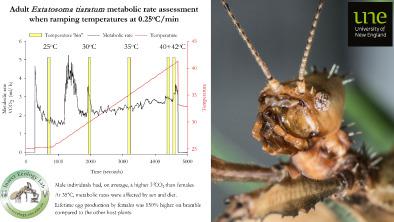当前位置:
X-MOL 学术
›
Physiol. Entomol.
›
论文详情
Our official English website, www.x-mol.net, welcomes your
feedback! (Note: you will need to create a separate account there.)
Impacts of temperature on metabolic rates of adult Extatosoma tiaratum reared on different host plant species
Physiological Entomology ( IF 1.6 ) Pub Date : 2019-10-23 , DOI: 10.1111/phen.12310 Sarah J. Hill 1 , Sarah C. Silcocks 1, 2 , Nigel R. Andrew 1
Physiological Entomology ( IF 1.6 ) Pub Date : 2019-10-23 , DOI: 10.1111/phen.12310 Sarah J. Hill 1 , Sarah C. Silcocks 1, 2 , Nigel R. Andrew 1
Affiliation

|
Access to balanced nutrition enables optimum health and development, body repair, fat storage, increased fecundity and longevity. In the present study, we assessed the responses of a generalist leaf feeder (the phasmid Extatosoma tiaratum) reared continuously on one of three host plants, tree lucerne (Chamaecyisus palmensis), bramble (Rubus fruticosus) and Eucalyptus species, in a low fluctuating temperature environment until adulthood. Once all individuals reached adulthood, we exposed each individual to a ramping temperature event (starting at 25 °C and ramping the temperature at 0.25 °C min−1) and assessed their metabolic rates ( V˙CO2 ) responses at specific temperature 'bins' (25, 30, 35, 40 and 42 °C). Sex but not diet influenced respiration and metabolic rate. Male individuals, on average, had a higher V˙CO2 than females. Sex and diet were significant influences on V˙CO2 at different temperatures. Metabolic rates at lower temperatures were not affected by sex or diet type. At 35 °C, metabolic rates were influenced by sex and diet, with males reared on bramble and tree lucerne having a higher metabolic rate than females reared on the same foodplant, whereas Eucalypt reared animals showing an opposite trend. Lifetime egg production by females was 150% higher on bramble compared with the other host plants. Incorporating fluctuating temperature ranges into experiments will further help to understand the impact that thermal stress will have on the growth, development, performance and survival of insects in a more variable climatic and nutritional landscape.
中文翻译:

温度对不同寄主植物种成体Extatosoma tiaratum代谢率的影响
获得均衡的营养可以实现最佳的健康和发育、身体修复、脂肪储存、增加繁殖力和寿命。在本研究中,我们评估了在低波动温度下,在三种寄主植物(紫花苜蓿(Chamaecyisus palmensis)、荆棘(Rubus fruticosus)和桉树种之一)上连续饲养的多面叶食虫(phasmid Extatosoma tiaratum)的反应环境直到成年。一旦所有个体都成年后,我们将每个个体暴露于温度升高事件(从 25 °C 开始,温度升高至 0.25 °C min-1),并评估他们在特定温度“箱”下的代谢率 (V·CO2) 响应(25、30、35、40 和 42 °C)。性别而不是饮食影响呼吸和代谢率。平均而言,男性个体的 V˙CO2 高于女性。性别和饮食对不同温度下的V˙CO2有显着影响。较低温度下的代谢率不受性别或饮食类型的影响。在 35 °C 时,代谢率受性别和饮食的影响,在荆棘和苜蓿上饲养的雄性比在同一食物植物上饲养的雌性具有更高的代谢率,而桉树饲养的动物则表现出相反的趋势。与其他寄主植物相比,荆棘上雌性的终生产蛋量高出 150%。将波动的温度范围纳入实验将进一步有助于了解热应激对昆虫在更可变的气候和营养景观中的生长、发育、性能和生存的影响。较低温度下的代谢率不受性别或饮食类型的影响。在 35 °C 时,代谢率受性别和饮食的影响,在荆棘和苜蓿上饲养的雄性比在同一食物植物上饲养的雌性具有更高的代谢率,而桉树饲养的动物则表现出相反的趋势。与其他寄主植物相比,荆棘上雌性的终生产蛋量高出 150%。将波动的温度范围纳入实验将进一步有助于了解热应激对昆虫在更可变的气候和营养景观中的生长、发育、性能和生存的影响。较低温度下的代谢率不受性别或饮食类型的影响。在 35 °C 时,代谢率受性别和饮食的影响,在荆棘和苜蓿上饲养的雄性比在同一食物植物上饲养的雌性具有更高的代谢率,而桉树饲养的动物则表现出相反的趋势。与其他寄主植物相比,荆棘上雌性的终生产蛋量高出 150%。将波动的温度范围纳入实验将进一步有助于了解热应激对昆虫在更可变的气候和营养景观中的生长、发育、性能和生存的影响。在荆棘和苜蓿上饲养的雄性比在同一食料植物上饲养的雌性具有更高的代谢率,而桉树饲养的动物则显示出相反的趋势。与其他寄主植物相比,荆棘上雌性的终生产蛋量高出 150%。将波动的温度范围纳入实验将进一步有助于了解热应激对昆虫在更可变的气候和营养景观中的生长、发育、性能和生存的影响。在荆棘和苜蓿上饲养的雄性比在同一食料植物上饲养的雌性具有更高的代谢率,而桉树饲养的动物则显示出相反的趋势。与其他寄主植物相比,荆棘上雌性的终生产蛋量高出 150%。将波动的温度范围纳入实验将进一步有助于了解热应激对昆虫在更可变的气候和营养景观中的生长、发育、性能和生存的影响。
更新日期:2019-10-23
中文翻译:

温度对不同寄主植物种成体Extatosoma tiaratum代谢率的影响
获得均衡的营养可以实现最佳的健康和发育、身体修复、脂肪储存、增加繁殖力和寿命。在本研究中,我们评估了在低波动温度下,在三种寄主植物(紫花苜蓿(Chamaecyisus palmensis)、荆棘(Rubus fruticosus)和桉树种之一)上连续饲养的多面叶食虫(phasmid Extatosoma tiaratum)的反应环境直到成年。一旦所有个体都成年后,我们将每个个体暴露于温度升高事件(从 25 °C 开始,温度升高至 0.25 °C min-1),并评估他们在特定温度“箱”下的代谢率 (V·CO2) 响应(25、30、35、40 和 42 °C)。性别而不是饮食影响呼吸和代谢率。平均而言,男性个体的 V˙CO2 高于女性。性别和饮食对不同温度下的V˙CO2有显着影响。较低温度下的代谢率不受性别或饮食类型的影响。在 35 °C 时,代谢率受性别和饮食的影响,在荆棘和苜蓿上饲养的雄性比在同一食物植物上饲养的雌性具有更高的代谢率,而桉树饲养的动物则表现出相反的趋势。与其他寄主植物相比,荆棘上雌性的终生产蛋量高出 150%。将波动的温度范围纳入实验将进一步有助于了解热应激对昆虫在更可变的气候和营养景观中的生长、发育、性能和生存的影响。较低温度下的代谢率不受性别或饮食类型的影响。在 35 °C 时,代谢率受性别和饮食的影响,在荆棘和苜蓿上饲养的雄性比在同一食物植物上饲养的雌性具有更高的代谢率,而桉树饲养的动物则表现出相反的趋势。与其他寄主植物相比,荆棘上雌性的终生产蛋量高出 150%。将波动的温度范围纳入实验将进一步有助于了解热应激对昆虫在更可变的气候和营养景观中的生长、发育、性能和生存的影响。较低温度下的代谢率不受性别或饮食类型的影响。在 35 °C 时,代谢率受性别和饮食的影响,在荆棘和苜蓿上饲养的雄性比在同一食物植物上饲养的雌性具有更高的代谢率,而桉树饲养的动物则表现出相反的趋势。与其他寄主植物相比,荆棘上雌性的终生产蛋量高出 150%。将波动的温度范围纳入实验将进一步有助于了解热应激对昆虫在更可变的气候和营养景观中的生长、发育、性能和生存的影响。在荆棘和苜蓿上饲养的雄性比在同一食料植物上饲养的雌性具有更高的代谢率,而桉树饲养的动物则显示出相反的趋势。与其他寄主植物相比,荆棘上雌性的终生产蛋量高出 150%。将波动的温度范围纳入实验将进一步有助于了解热应激对昆虫在更可变的气候和营养景观中的生长、发育、性能和生存的影响。在荆棘和苜蓿上饲养的雄性比在同一食料植物上饲养的雌性具有更高的代谢率,而桉树饲养的动物则显示出相反的趋势。与其他寄主植物相比,荆棘上雌性的终生产蛋量高出 150%。将波动的温度范围纳入实验将进一步有助于了解热应激对昆虫在更可变的气候和营养景观中的生长、发育、性能和生存的影响。











































 京公网安备 11010802027423号
京公网安备 11010802027423号